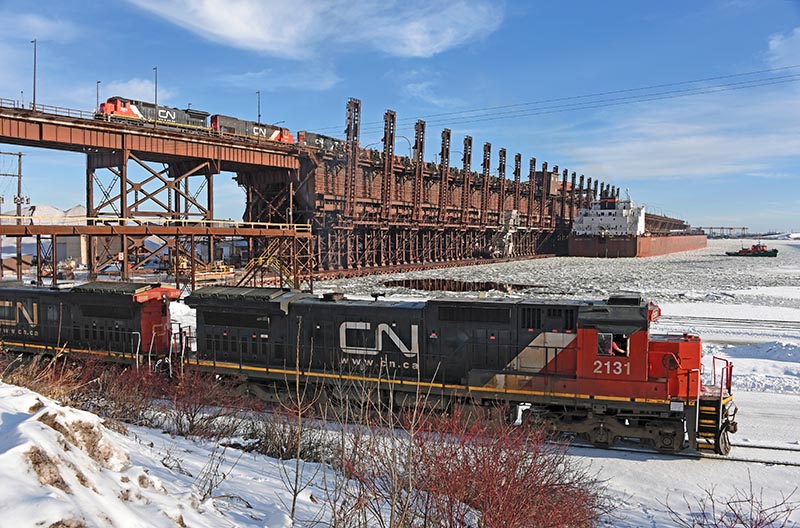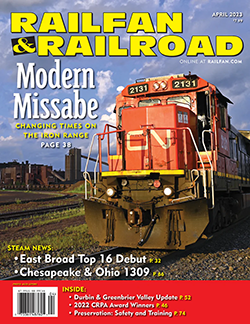 by Kevin Madsen/photos as noted
by Kevin Madsen/photos as noted
There isn’t really an unexplored piece of the Missabe. The former Duluth, Missabe & Iron Range — now operated by Canadian National — has been a railfan favorite since the waning days of steam when its monstrous 2-8-8-4 Yellowstone-class steam locomotives were still hauling iron ore from the mines to Lake Superior as late as 1960! The diesel era drew attention as well, as the railroad ran mostly with EMD SD9s and SD18s, adding different variations of SD38s beginning in the early 1970s. The Missabe did not truly invest in turbocharged locomotives until acquiring rebuilt SD40 variants (most of which were ex-Southern Pacific tunnel motors) in 1996.
The motive power isn’t the only attraction that draws a crowd. Classic 24-foot-long ore cars — definitely not “jennies” — that trailed the mighty Yellowstones still follow DMIR motive power today, as well as a motley mix of other elderly and aging EMD and GE locomotives. Once again the locomotive fleet is about to go through a change, while the ore cars near their seventh and eighth decades of service. There is one more thing that draws a crowd, however.
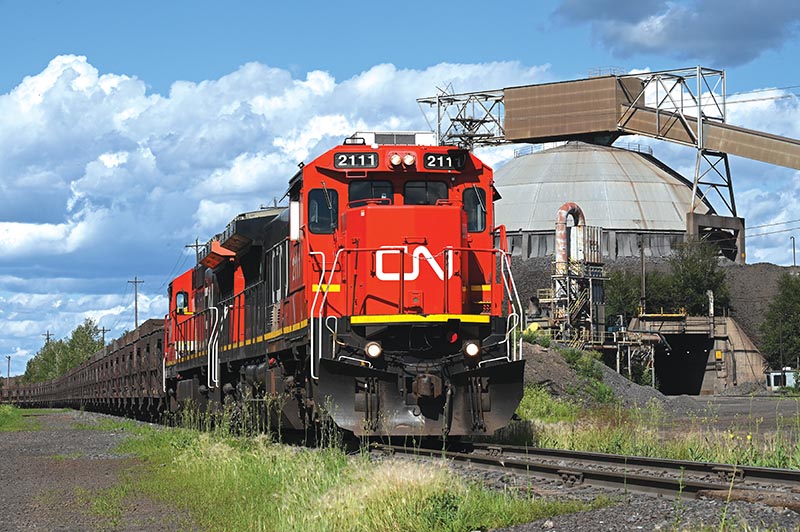
ABOVE: “The Thunderdome” at UTAC’s Thunderbird mine is the rock crusher where ore delivered by haul trucks is loaded into CN’s “T-Bird” trains for the trip to Fairlane. Standard power of a pair of C40-8s is here on July 21, 2022. —Todd Mavec photo
The Range
There’s an explosion on the outskirts of Virginia, Minn. Actually, there is a rapid series of explosions that send dirt and dust airborne. Nobody seems to take much notice as it’s blasting day at Cleveland-Cliff’s United Taconite mine. The Mesabi Iron Range (as the geological formation containing the iron ore reserves is known) has six mines and the explosion of rock is not only a fact of life, but provides for the way of life on the range. United Taconite operates the Thunderbird Mine and the Fairlane taconite production plant, each so named because the facilities were once owned by Ford Motor Co.
After the blast, a huge excavator (shovel) will continually load massive haul trucks that bring the rock to the crusher. At United Taconite, the crusher is located at the Thunderbird North loadout where a constant stream of trains is loaded to take the rock to the Fairlane plant nine miles down CN’s Missabe Subdivision near Forbes. At the Fairlane plant, the rock is processed to separate the taconite ore (which makes up about 30 percent of the rock) from the tailings and overburden. Taconite is then ground into a slurry before being mixed with bentonite clay and limestone and baked at 2,400 degrees Fahrenheit to create taconite pellets. The taconite pellets resemble blueberries and are ferried out of the plant by a series of conveyors to either go to a stockpile or to be directly loaded onto a train, producing steam as soon as they’re hit by the colder air.
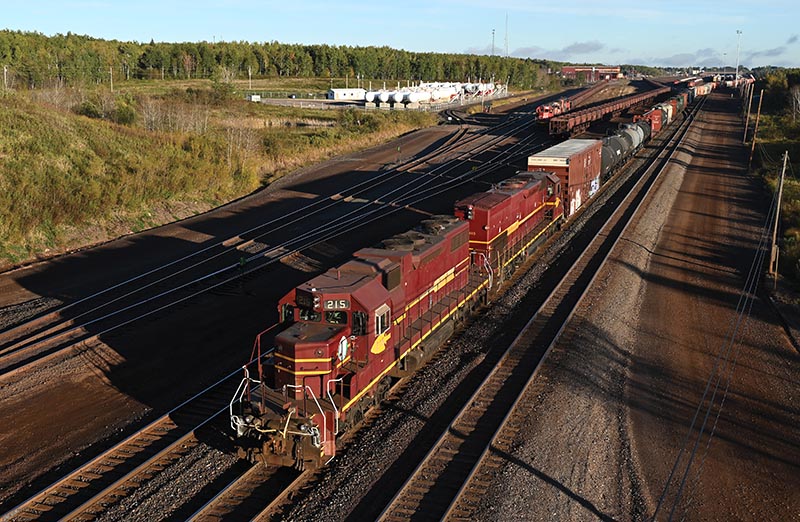
ABOVE: Railfan-minded Missabe managers have played a role in creating some incredible consists from their pool of captive power in recent years. Proctor’s “E-Lead” yard job swings a string of cars to be classified from the F Yard to the E Yard. The ore cars and set of power in the background are in A Yard. DMIR SD38-2 215 is a permanent resident of Proctor and the trailing locomotive, DMIR SD40-3 403, has been repatriated from its normal home in Thunder Bay, Ont., for a couple of short stretches in recent years. These two locomotives are the last Missabe-painted locomotives on the CN roster. —C.N. Southwell photo
It wasn’t always this way on the range. The U.S.’s incredible demand for high-quality iron ore depleted the area’s easier-to-mine reserves of unprocessed ore by the early 1950s. The unprocessed ore was located close to the surface and contained an ore content above 50 percent. Although many mines simply ceased operation after the depletion of unprocessed ore (resulting in many abandoned railroad grades through the area), others found economical ways to process and extract ore from the taconite rock.
Tower, Merritt, and the First Rails from the Range
Charlemagne Tower formed Duluth & Iron Mountain Railroad on January 29, 1881. His business partner, George C. Stone, had been procuring title to iron ore lands by handpicking residents to “homestead” the land with the understanding that they would convey the title to him. Stone and Tower conspired to acquire a soon-to-expire land grant that had been given to Duluth & Iron Range Railroad in 1874. Surveying of the line from Tower to Agate Bay (soon to be renamed Two Harbors) began in 1880.
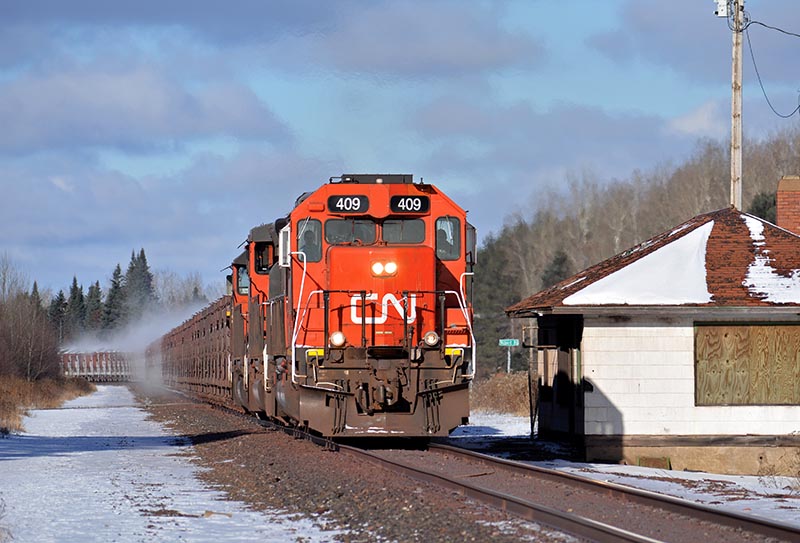
ABOVE: DMIR 409 South is passing the last depot standing along the main line at Saginaw on November 13, 2018. Saginaw was once the location of the interchange between DM&IR and Duluth & Northeastern, a logging and paper mill railroad that has been succeeded by Cloquet Terminal. —C.N. Southwell photo
The first D&IR train departed Two Harbors on July 31, 1884, consisting of locomotive 8, caboose 21, and 10 empty wooden ore cars capable of carrying 20 tons apiece. After being loaded at Soudan, the train returned to Two Harbors, making stops to siphon water from streams as watering facilities for locomotives had not yet been built.
In 1890, D&IR built a line west from Allen Junction to McKinley, just west of Biwabik. Throughout the 1890s, D&IR would build west from McKinley to Virginia, Fayal, and Eveleth to compete directly with Duluth, Missabe & Northern. By 1901, D&IR was owned by U.S. Steel.
“I tell you, there’s iron up there worth more than all the gold in California!” Lewis H. Merritt told his sons after exploring the Mesabi Range in the 1860s. In 1885, his sons set out to prove their father right and found ore only 14 feet underground near a town they would soon name Mountain Iron. On June 23, 1891, the Merritts incorporated Duluth, Missabe & Northern Railway. The preliminary survey of the line from Mountain Iron to Stony Brook Junction (now known as Brookston) was to slope down so gently from the Mesabi Range to Lake Superior that loaded ore cars could roll from the mine to the lake if given a good shove. Construction of a branch from Iron Junction to Biwabik had begun before the original line was completed. The southern terminus of Stony Brook and the running of DM&N trains over Duluth & Winnipeg (which would later become part of Great Northern) from there to its dock at Allouez were never intended to last…


